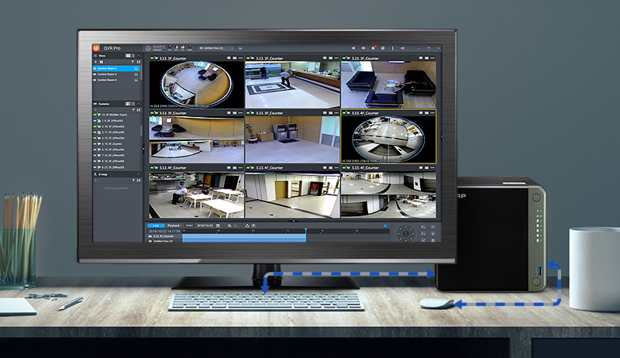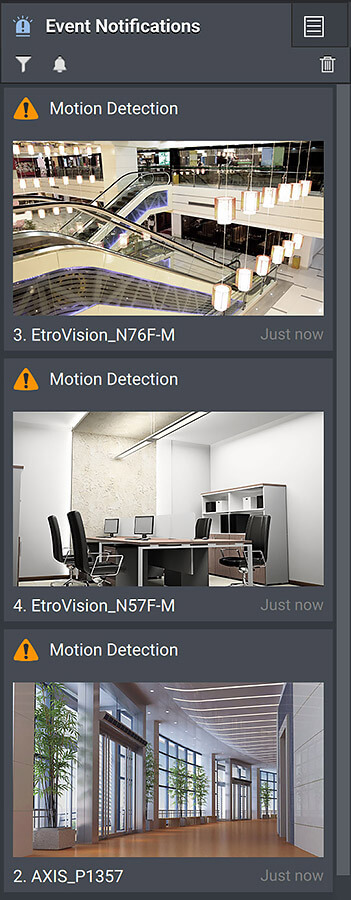
#QVR CLIENT QNAP PRO#
So this "server error" when I attempt to login with the QVR Pro Client is my remaining problem. Test Environment: NAS: TS-h2287XU-RP-E2378-64G OS: QuTS hero h5.0.0 Volume type: Samsung 860 EVO 1TB x22 (RAID 50, 11 x2) QXG-25G2SF-CX6 Client PC: 6 Client PC simultaneously read and write 16GB file ( 96GB totally) Intel Core i7-7700 4. QVR Face is a smart facial recognition solution featuring real-time live streaming video analytics from connected cameras. That worked and everything I can look at in Surveillance Station appears normal and is recording the camera data stream properly. QVR Pro Client provides an intuitive interface for your QVR Pro / Elite server, helping you manage IP cameras, monitor live views, and play back previous recordings using your mobile devices. So when I first set it up and it didn't work, I connected the second port on the NAS to my secondary router so got a dual network scheme. The camera connects to a secondary router using a 192.168.5.x IP scheme.

The NAS uses the normal 192.168.0.x IP scheme and connects directly to the ISP's router using DHCP. I do have a dual network setup on the NAS:

#QVR CLIENT QNAP INSTALL#
So I think I have the right install stuff, tho possibly missing some library but it is not defined as far as I can tell. That setups the install in the folder QVRProClient in my Home directory and the run.sh file. QVRProClientInstaller-1.3.0.1-ubuntu-1604.tgz when extracted has the file QVRProClientInstaller-1.3.0.n. I got the client file from the QNAP site: The qvrpro video uses another nic for the few cameras that server is supporting.

This is all on the same internal network and I have a separate NIC on the qvrcenter server just for qvrcenter management traffic (400 KB/s which is 3.2mbps on 1 1Gbps link). I have no clue what this is or if it is even applicable to my 'server error' problem. I believe this to be an issue with the QVRcenter losing is connection with the client. Multiple video sources are supported - not just IP cameras.Įasily add cameras from different networks, providing greater convenience for organizations with multi-network environments.Log4cplus:ERROR Propert圜onfigurator::configureAppenders()- Cannot find AppenderFactory: log4cplus::Win32DebugAppender Supports RTSP, RTMP, JPEG, and ONVIF Profile S/T protocols for recording the stream into QVR Elite, with no integration needed. Identical cameras can be added with the same settings.Īssign dedicated bandwidth to each camera to optimize the use of NAS system resources and ensure smoother recordings. Save time deploying cameras by batch adding them. It is designed to provide users with a powerful surveillance management solution that offers an array of features to help them monitor and manage their surveillance systems more efficiently. QNAP LIC-SW-QVRPRO Overview 8 additional camera licenses Camera channel scalability Unlimited recording playback via QVR Pro Client Flexible recording space. QVR Center is a central management solution for QVR Elite, QVR Pro, and older Surveillance Station, and VioStor NVR systems.
#QVR CLIENT QNAP SOFTWARE#
QVR Elite supports over 6700 IP cameras from 190 renowned brands, including ONVIF compatible cameras. QNAP QVR Client is a software application developed by the tech company QNAP Systems, Inc. Whether using default or custom roles, these privilege settings allow for managing and monitoring up to 256 servers and 16,384 cameras. Custom roles can be created based on privileges and rights. You can scale up your surveillance requirements by subscribing up to 192 channel licenses. QVR Center provides 3 default roles for monitoring: Administrator, Supervisor, and Viewer.
#QVR CLIENT QNAP FULL#
Includes 2 Free Channels - Expandable to 192 Channelsĭownload and start using QVR Elite with 2 free embedded channels. The QVR Pro Client client software can be installed on Windows and Mac devices or in QNAP’s HD Station on NAS, allowing you to monitor from different platforms and flexibly switch from live view or playback mode to take full control over the monitored area. The NAS will then run through the installation process and will reboot.


 0 kommentar(er)
0 kommentar(er)
